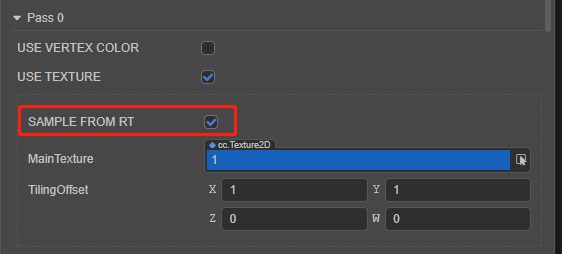RenderTexture
A rendered texture is a texture on the GPU. Usually, we set it to the camera's target texture, so that the content illuminated by the camera is drawn to the texture through the frambuffer off the screen.
Using RenderTexture
There are two ways to use RenderTexture:
Method 1: Draw the contents illuminated by the 3D camera to the sprite frame of the UI.
typescriptexport class CaptureToWeb extends Component { @property(Sprite) sprite: Sprite = null; @property(Camera) camera: Camera = null; protected _renderTex: RenderTexture = null; start () { const spriteframe = this.sprite.spriteFrame; const sp = new SpriteFrame(); sp.reset({ originalSize: spriteframe.getOriginalSize(), rect: spriteframe.getRect(), offset: spriteframe.getOffset(), isRotate: spriteframe.isRotated(), borderTop: spriteframe.insetTop, borderLeft: spriteframe.insetLeft, borderBottom: spriteframe.insetBottom, borderRight: spriteframe.insetRight, }); const renderTex = this._renderTex = new RenderTexture(); renderTex.reset({ width: 256, height: 256, colorFormat: RenderTexture.PixelFormat.RGBA8888, depthStencilFormat: RenderTexture.DepthStencilFormat.DEPTH_24_STENCIL_8 }); this.camera.targetTexture = renderTex; sp.texture = renderTex; this.sprite.spriteFrame = sp; // Need to manually call this function to make RenderTexture display correctly on each platform this.sprite.updateMaterial(); } }Method 2: Draw the contents illuminated by the 3D camera to the 3D model.
typescriptexport class RenderCameraToModel extends Component { @property(MeshRenderer) model: MeshRenderer = null; start () { // Your initialization goes here. const renderTex = new RenderTexture(); renderTex.reset({ width: 256, height: 256, colorFormat: RenderTexture.PixelFormat.RGBA8888, depthStencilFormat: RenderTexture.DepthStencilFormat.DEPTH_24_STENCIL_8, }); const cameraComp = this.getComponent(Camera); cameraComp.targetTexture = renderTex; const pass = this.model.material.passes[0]; // Set the 'SAMPLE_FROM_RT' macro to 'true' so that RenderTexture can be displayed correctly on each platform const defines = { SAMPLE_FROM_RT: true, ...pass.defines }; const renderMat = new Material(); renderMat.initialize({ effectAsset: this.model.material.effectAsset, defines, }); this.model.setMaterial(renderMat, 0); renderMat.setProperty('mainTexture', renderTex, 0); } }
Set RenderTexture as a texture map
Setting the RenderTexture to a texture map consists of the following two steps:
Process
uvineffectDetermine
SAMPLE_FROM_RTand callCC_HANDLE_RT_SAMPLE_FLIPfunction:#if USE_TEXTURE v_uv = a_texCoord * tilingOffset.xy + tilingOffset.zw; #if SAMPLE_FROM_RT CC_HANDLE_RT_SAMPLE_FLIP(v_uv); #endif #endifSelect the corresponding material in the Hierarchy panel, and then check
SAMPLE FROM RTin the Inspector panel.
For more information about the usage, please refer to the example RenderTexture.